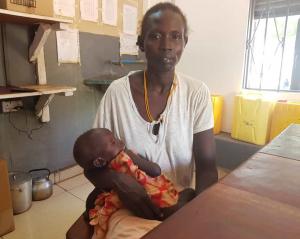Saving children from severe acute malnutrition in South Sudan’s Greater Lakes region
Aluak Bol arrived at the health facility anxious about the health of her 18-month-old daughter, Apen Magot Mabeny. She had a fever, excessive mouth salivation and poor appetite. She cried horribly when urinating, which was reddened.
“We don’t have enough food to feed our children, especially during the dry season. Because of this condition, she is 18 months old but she doesn’t talk and walk compared to children her age,” Aluak tells the certified midwife on duty. She has five other children at home in the village of Cuei-cok in Rumbek Center, the former Lakes State.
“My daughter has not been well,” she continues. “She has frequent attacks of diarrhoea and a respiratory tract infection. This is her second time to be admitted to the stabilization centre in Rumbek Hospital.”
Apen is quickly referred to the stabilization centre at Rumbek Hospital, which is the only facility in Rumbek, Former Lakes State capable of treating malnourished children.
“Apen was an obvious case of severe acute malnutrition with a medical complication, weighing 6.3 kg and was immediately admitted into the stabilization centre for treatment,” says Martha Aping Dut, a nurse who works in Rumbek Hospital stabilization center supported by CUAMM, a non-governmental organization. She was treated with the World Health Organization’s (WHO) severe acute malnutrition kit for seven days.
By the time she was discharged, she had an appetite, had gained 1 kg of weight and was given ready-to-use therapeutic food.
“I and my husband were hopeless when I brought the child to the hospital. I thought she was going to die. On my arrival at the hospital, my child was given lifesaving drugs and milk, and I gradually saw my daughter improve. Every day she got better, and every day there was progress,” says her mother.
WHO helping worst cases of malnutrition in children
As measured by the latest Integrated Food Security Phase Classification, nearly 5 million people (39%) of the total population are expected to face severe food insecurity in the absence of comprehensive humanitarian assistance in the period of September to December 2019. An estimated 292 300 children are suffering or will likely be suffering by December from severe acute malnutrition. Of them, some 10% are expected to develop associated medical complications.
To reduce the health impact of the nutrition emergency in areas with the highest burden of severe acute malnutrition, WHO and partners are working to improve access to treatment. This includes providing essential medicines to 20 stabilization centres located in the counties with high global acute malnutrition (GAM) rates and developing national guidelines along with capacity-building programmes and disease surveillance.
WHO, in collaboration with nutrition partners, has provided extensive training on the management of severe acute malnutrition with medical complications, and have installed water-quality control systems and psychosocial support for caretakers of hospitalized children. They are also monitoring the quality of service provision in the stabilization centres.
To date for 2019, WHO has donated 43 severe acute malnutrition kits to the counties with a high rate of acute malnutrition in five states that were used to treat around 2 150 children who were at high risk of dying.
The WHO severe acute malnutrition kit provides medical treatment for 50 children younger than 5 years: antibiotics; antifungal, de-worming, antimalarial and anti-scabies medicines and a rehydration mix specific to treat severe acute malnutrition.
“It is our top priority to prevent children from dying of severe acute malnutrition,” says Dr Olushayo Olu, WHO Representative in South Sudan. “Thanks to the continued support of the South Sudan Humanitarian Fund, WHO is taking every opportunity to make lifesaving interventions available, from locating children in need to the quick treatment of malnourished children.”
“In the stabilization centre, we provide not only the treatment for severe acute malnutrition with medical complications but also health education to mothers and caregivers of the admitted children on a balanced diet. And we offer psychological support and screening of specific causes to save the lives of children,” says Dut, the nurse who admitted baby Apen.
It is working she says, having inspected her centre’s records that indicate a reduction of deaths related to severe acute malnutrition.
Baby Apen’s mother is the latest testament to the lifesaving interventions. “Today, my child is alive! Without these services, I would have lost her – the facility saves lives of innocent children like mine.”
She leaves the hospital vowing to give back by helping forward: “So many children are dying of malnutrition due to lack of knowledge on the availability and accessibility of the stabilization centre in the Greater Lakes region. I will mobilize and advise all mothers whose children are malnourished to use the services in the stabilization centre.”
State Coordinator, Rumbek, Lakes Hub
Mobile: +211 929216664
Email: garangs [at] who.int (garangs[at]who[dot]int)
Nutrition Officer
mesekal [at] who.int (mesekal[at]who[dot]int)
Communications Officer
WHO Rwanda
Mobile: +250 795 450 856
Email: ebrahimj [at] who.int (ebrahimj[at]who[dot]int)



